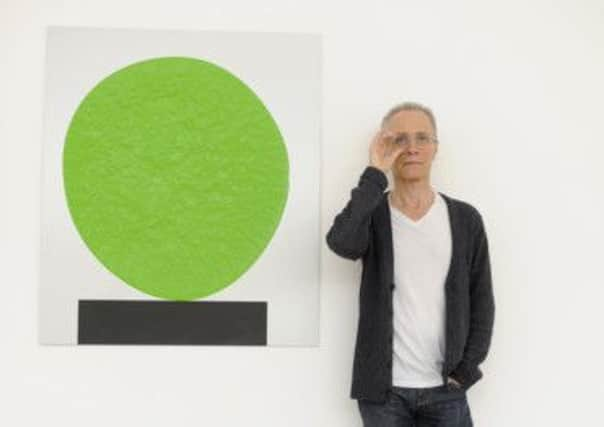Art review: David Batchelor - Flatlands, Edinburgh


Whatever you think of it, October is serious. It declares its seriousness in lots of ways: long words, continental theory, dense type. But most of all it does so by being entirely monochrome apart from the issue number on its cover. An art magazine. In black and white.
So, it’s an absolute delight that amongst the works on show in David Batchelor’s new show of drawings and paintings, Flatlands, at Edinburgh Fruitmarket is the series The October Colouring-In Book. It’s an eviscerated copy of October, in which the pages have been transformed with marker pen into ziggurats and jigsaws of colour, pulsating pages of pink and magenta dots, towers of bright pigment and dark skies and constellations of colourful lozenges.
Advertisement
Hide AdWhere does Batchelor stand on October? I wouldn’t be so quick to imagine it’s straightforward hostility. He has, after all, kept the copy he has worked on, the very first issue, for some 35 years. In parallel with his art career, he has spent many years of teaching wading through the fertile swamps of art theory, and the trick I think he demonstrates with a lovely lightness of touch is not to get bogged down.
Batchelor is the author of an important book on Minimalism and a tiny, delightfully readable, yet extremely erudite polemic on colour entitled Chromophobia. His contention that Western culture is afraid of colour, marginalises it as decoration, exoticises it as foreign, is well argued. The colour he is interested in is the crazy, saturated colour of the city, the spraypaint sheen of cars, neon glow of signage, the zing of household paints fresh from the pot.
The artist was born in Dundee, where the refurbished McManus Gallery recently commissioned Waldela, one of his light installations crafted from empty plastic bottles and tangles of wire and lightbulbs. His trays of pigment resting on industrial dollies, glowing stacks of refurbished lightboxes and incandescent candelabra are key works of British art, a riposte to the black and white, typewritten world of much recent art, but not a reactionary one. Edinburgh folk might remember his Candela, a chandelier of glowing plastic tumbling down through the Palm House at the Royal Botanic Garden, or Unplugged, his 2007 show at the Talbot Rice of sculptures made entirely from household plastics like sunglasses or pot scrubbers.
This show is dedicated to 150 drawings and paintings, a constant but lesser known pre-occupation of his practice. There are his working drawings, with scribbled instructions and paint charts on graph paper and a lovely near room-sized installation of 57 of his Atomic Drawings. These are charming and immediate, unstable dollops of acid colour, accretions of pink masking tape, and sticky black gaffer tape. Big unwieldy blobs of fluorescent green teeter on small blocks like wobbly sculptures on plinths. Their materials are not precious, but the stuff that comes to hand: card and tape, spraypaint and marker pen, acrylic and household gloss.
Upstairs, the show is dedicated to a new body of work: so-called Blob Paintings, made by pouring industrial paints on to thin grey sheets of aluminium. Wobbled around, the paint pools into irregular shapes and when it dries it wrinkles like the skin on custard. Each blob sits, precariously on a black rectangle that acts like a pedestal would for a sculpture. But if these were sculptures they would surely fall over.
The blob paintings are robust, serious but somehow also incredibly funny. You could talk for hours about their art historical precedents, while basking in their saturated colour, and you’d be right to make these connections. But I also like to remember they are made by the same artist who has scoured the streets of King’s Cross for industrial leftovers and spent hours in supermarket checkouts processing hundreds of bottles of bleach and toilet cleaner for their jewel-like containers.
Advertisement
Hide AdFlatlands has many of the strength of the Fruitmarket’s programme: it is rigorously themed: two-dimensional works only from an artist best known for three. It is well connected: it is curated by Andrea Schlieker, who conceived and directed the Folkstone Triennial. But it also has what might become a weakness, a danger that the intense focus can sometimes leave you feeling that you have missed something vital in your peripheral vision.
Batchelor’s drawings and poured paint works are absolutely delightful, and they are a story that was waiting to be told. But on their own they risk presenting an almost sanitised version of what is an exuberant, and at times much grimier, body of work. Studio photographs show some of the works in proximity to ephemera and working models for the sculpture. You can glimpse the outside world through the studio windows. Much as I would recommend you visit this lovely show, I longed for a bit more of that clutter and everyday noise.
Twitter: @moirajeffrey
• David Batchelor, Flatlands is at the Fruitmarket Gallery, Edinburgh, until 14 July